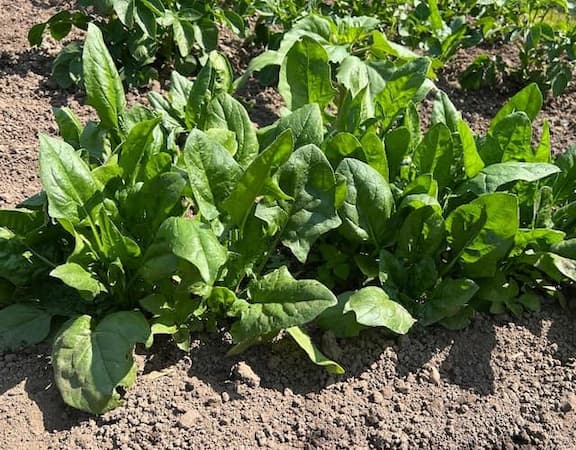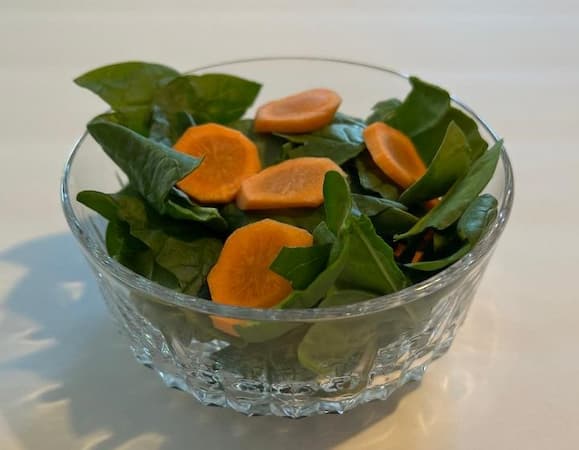How to Grow Spinach Greens

While lettuce is the “King of the Greens”, spinach has good reasons to hold its leaves up proudly. Growing spinach is the second most popular garden green. In addition to tasting good, this thick-leaved green is among the most nutritious vegetables you can eat. It is eaten raw or cooked. Use this guide to learn how to grow spinach. Then, buy some spinach seeds and get growing today.
A generation ago, kids were threatened with a variety of punishments if you do not “eat your spinach”. While parents don’t push eating spinach as much today as our parents did, perhaps they should. From a nutrition standpoint, perhaps we should. Whether our parents knew it or not, spinach truly is good for you. It is packed with vitamins and minerals. Even Popeye knew the benefits of this healthy food.
When we speak of spinach, most people still think about cooked leaves, which are boiled into an often mushy, unappealing green mass. It is amazing how many people have never tried the mild-flavored spinach in a salad. Fewer still, think about where they can use these greens. They mix well in many recipes and can be found in places like stuffed shells, lasagna, and soups.
Spinach is a hardy, cool weather crop. It grows best in spring and fall and survives frosts and even freezes.
Garden Tip: For an early crop when prices in the stores are still high, try growing spinach in a container on your deck, in a sunroom, or inside a cold frame.
Did you Know? Spinach is an ingredient of one of the most popular tomato vegetable juices? That’s right, without Spinach, V8 would only be V7.
Varieties of Spinach
Smooth leaves
Savoyed or crumpled leaves
Bloomsdale Longstanding is the most common variety.
New Zealand – not a true spinach, grows well in warm weather
Sowing Spinach Seeds
Spinach seeds are small. Plant in rows, spreading the seeds as thinly as possible. No matter how hard you try, the spinach seeds are difficult to disperse. Thinning seedlings is a must. Cover the seeds with a very fine layer of loose soil or starting mixture.
Final Spacing: Space plants one inch apart, in rows 12″ to 15″ inches apart. Plant smaller varieties at the minimum for this range, and larger varieties at or near the maximum.
For maximum growth, avoid overcrowding. However, the plants will tolerate a little crowding.

How to Grow Spinach
Grow plants in full sun. The plants like cool weather and lots of moisture in rich, well-drained soil.
Growing spinach at a fast pace produces the most flavorful, and tender leaves. That means plenty of water and a healthy dose of fertilizer. Keep plants well weeded, too.
TIP: Use succession planting, by sowing a row or partial row every two weeks. This will provide fresh greens for most of the year.
When using succession planting, as the plants age and lose their vigor, the next crop is ready to harvest.
The plants do not like summer’s heat and humidity. Plant a fall crop as soon as the weather begins to cool, and you will have spinach all the way up to the first frost. For warmer summer weather, try New Zealand Spinach.
Ideal Soil pH: 6.0 – 7.5
Also, see:
Soil Temperatures – Ideal germination temperature by vegetable
Ideal Soil pH – by vegetable
Insects and Pests
Regardless of whether people like spinach, it is certain that insects and some animals do…especially bunnies. For the bunnies, a rabbit fence is in your future. For insects, some insecticides can be applied but require several days before you can harvest the leaves. We like to avoid insecticides on leafy vegetables wherever possible.
We suggest organic sprays, and a willingness to give up some of the harvest to insects, overusing pesticides. After all, one of the reasons most of us have gardens is to avoid the pesticides.
Plant Disease
The plants are fairly resistant to most plant diseases. However, it will wilt and rot in hot, humid weather. The plant will also bolt, or go to the seed stage, in high when the weather gets hot.
Plant Problems – Diagnosis, causes, and cures for many common plant problems.
Harvesting Spinach
Days to Harvest: 45 to 50 days. Plants produce vigorous, healthy greens for 2-3 weeks. Succession planting will allow successive crops to reach maturity, as older plants lose their vigor or bolt.
The leaves can be harvested as soon as they have reached a size that you can use.
Spinach Plant Hardiness
Like most leafy vegetables, the plants thrive in cooler weather, with moderate moisture. It does not like mid-summer heat and dry conditions. However, you will find some varieties that are slow to bolt. Many gardeners plant a crop for spring and early summer harvest and leave the mid-summer months to heat-loving tomatoes and corn. Then, as the late summer heat begins to wane, they plant a crop for late fall harvest.
Plants survive a light frost, and even freezes.
Spinach Recipes
Related Articles
People who like this page, also like:
National Spinach Day. It is a vegetable to celebrate with its own national day. You can do just that on March 26th.
Please support our site. Shop for:
- rmmatthews100@hotmail.com
- 585-721-6528
- Rochester, NY
©1999-2024 GardenersNet.Com, All Rights Reserved

